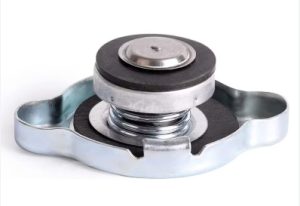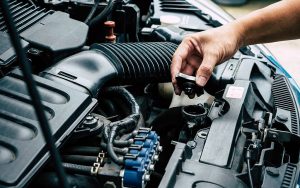When we think of a car’s cooling system, the focus often goes to the radiator or the thermostat — but there’s one often-overlooked hero playing a vital role in engine health: the radiator pressure cap. This small, inexpensive component is essential for maintaining the correct pressure inside the cooling system, ensuring optimal performance, and preventing engine overheating or coolant loss.
In this article, we’ll explore how radiator caps work, what makes them so important, how to maintain them, and when to replace them.
What Is a Radiator Pressure Cap?

A radiator pressure cap is more than just a lid. It’s a precision-engineered pressure release valve designed to maintain the correct pressure in your vehicle’s cooling system. It regulates pressure by sealing the system and venting when needed — typically at 13–16 psi (0.9–1.1 bar) for most cars.
Why Pressure Matters in the Cooling System
Increasing pressure inside a sealed cooling system raises the boiling point of the coolant, allowing the engine to run hotter without the coolant boiling over. This improves thermal efficiency and reduces the risk of overheating.
Cooling System Pressure & Boiling Point Relationship
| System Pressure | Boiling Point of Coolant (°C) |
|---|---|
| Atmospheric (0 psi) | ~100°C |
| 7 psi | ~114°C |
| 15 psi | ~121°C |
A properly functioning pressure cap can raise the coolant boiling point by over 20°C.
How a Radiator Cap Works
The radiator cap typically contains two spring-loaded valves:
-
Pressure Valve: Opens if pressure exceeds its rating, allowing coolant to escape to the overflow tank.
-
Vacuum Valve: Opens to allow coolant or air back into the system when it cools and contracts, preventing hose collapse.
Basic Operation Flow:
-
Normal Operation: Cap remains sealed, pressure builds with heat.
-
Excess Pressure: Valve opens → coolant flows to reservoir.
-
Engine Cools: Vacuum created → coolant is drawn back in via vacuum valve.
Components of a Radiator Cap
| Part | Function |
|---|---|
| Spring-loaded seal | Maintains system pressure |
| Pressure valve | Releases pressure when limits exceeded |
| Vacuum valve | Prevents hose collapse when cooling |
| Rubber gasket | Ensures a tight seal |
| Metal housing | Durable body that threads onto radiator |
Signs of a Faulty Radiator Cap
Even a small malfunction can cause cooling issues. Watch for these symptoms:
-
Coolant leakage near the radiator or overflow tank
-
Overheating despite sufficient coolant levels
-
Collapsed radiator hoses
-
Air pockets in the cooling system
-
Coolant boiling over or steaming
-
Low coolant in overflow tank, with no visible leaks
Common Issues Caused by a Bad Radiator Cap
| Problem | Likely Cause from Cap | Solution |
|---|---|---|
| Overheating | Cap not holding pressure | Replace with correct pressure cap |
| Coolant loss | Cap venting too early | Check spring & gasket integrity |
| Air in system | Bad vacuum valve | Replace cap |
| Hose collapse | Vacuum valve not opening | Replace cap |
How to Test a Radiator Cap
Most auto shops can pressure test a cap using a hand pump and gauge. You can also check manually:
-
Inspect the rubber seal for cracks or stiffness.
-
Squeeze the spring mechanism — it should offer resistance.
-
Shake the cap — loose or rattling parts indicate failure.
Radiator Cap Maintenance Tips
-
Replace every 3–5 years, even if no obvious issues.
-
Always use the correct pressure rating (found in your owner’s manual).
-
Clean the filler neck to ensure a tight seal.
-
Never open a hot radiator — pressure release can cause burns.
-
Check cap when flushing coolant or doing cooling system work.
Recommended Maintenance Schedule
| Task | Frequency | Purpose |
|---|---|---|
| Inspect cap & gasket | Every oil change | Detect cracks, rust, aging |
| Replace cap | Every 3–5 years | Maintain proper pressure control |
| Flush coolant system | Every 2–3 years | Prevent corrosion & sediment |
Choosing the Right Radiator Cap

Choosing the wrong cap can lead to overpressure or underperformance. Consider:
-
Correct pressure rating (e.g., 13 psi or 16 psi)
-
Fit type: Threaded vs. twist-lock vs. expansion tank style
-
Material: OEM metal caps or aftermarket aluminum/plastic hybrids
-
Compatibility with your radiator neck or reservoir system
Cap Types Comparison
| Type | Used On | Notes |
|---|---|---|
| Radiator-mounted | Older vehicles, open systems | Seals directly to radiator neck |
| Reservoir-mounted | Most modern vehicles | Cap located on coolant reservoir |
| Racing caps | Performance vehicles | Higher psi, reinforced internals |
Where to Buy Quality Radiator Components
Whether you’re replacing an aging cap or upgrading your cooling system, don’t skimp on quality. A faulty cap can cost you an engine.
Buy Radiator & Components online — find durable, OEM-grade radiator caps and other cooling parts that fit your car and performance needs.
Final Thoughts
The radiator pressure cap might seem like a minor detail, but it plays a major role in the health of your engine. It maintains pressure, regulates coolant flow, and prevents catastrophic overheating. Regular inspection and timely replacement of this component can save you hundreds in repairs and extend the life of your vehicle.
So the next time you’re checking fluids or doing a seasonal coolant flush, don’t forget the cap — small part, big role.